El Niño is developing rapidly, with an official watch currently in effect, issued by NOAA. A moderate to strong El Niño event is expected to occur, with global weather impacts in the second half of the year and over the Winter season of 2023/2024. Based on the latest global anomaly data, this El Niño might be something we have never seen before in such an environment.
Ocean anomalies have a known impact on the atmosphere and our weather on smaller and larger scales, especially during the Winter season, when the pressure systems are strongest.
First, we will quickly look at the connection between the oceans and the atmosphere. Then you will see how El Niño is currently growing and how it is expected to influence the upcoming weather seasons, from the Hurricane season to the Winter 2023/2024.

HOW OCEAN MEETS THE ATMOSPHERE
El Niño is a phase of the ENSO, which stands for “El Niño Southern Oscillation.” This region of the equatorial Pacific Ocean regularly shifts between warm and cold phases. Typically there is a phase change around every 1-3 years.
The image below shows the ENSO regions across the tropical Pacific. Regions 3 and 4 expand over the east and west tropical Pacific. The main area combines regions 3 and 4, seen in the image as the Nino 3.4 region. But notice the regions 1+2, as they play an important role.

Each ENSO phase influences the pressure and weather in the tropics differently. This affects the overall global circulation over time, changing the weather patterns worldwide.
A (cold/warm) phase usually develops between late Summer and early Fall. It then lasts until Spring, but some events can last up to two or three years. The last phase was a cold La Niña and it spanned three years.
The cold ENSO phase is called La Niña, and the warm phase is called El Niño. Besides the ocean temperatures, one of the main differences between the phases is the pressure patterns they promote, seen below as high (H) and low (L) pressure zones.

During an El Niño, the pressure over the tropical Pacific drops, with more rainfall and storms in this region. But during a La Niña, the pressure over the equatorial Pacific rises, creating stable conditions and fewer storms.
These pressure changes translate into global circulation over time, affecting seasonal weather over both Hemispheres. We can observe a global shift in pressure patterns during the emergence of an ENSO phase. But it is usually more influential during the peak of its phase in Fall and Winter.
The following image below from NOAA Climate shows the typical circulation during an El Niño event, which will be the dominant phase for the next 10 months at least.
Rising air in the eastern Pacific causes more storms and precipitation and lowers the pressure over that region. At the same time, the air is descending in the western Pacific, causing stable weather and high-pressure conditions.

This way, ENSO strongly impacts the tropical rainfall and pressure patterns, affecting the ocean-atmosphere feedback system. Through this ocean-atmosphere system, the ENSO influences the weather globally.
THE WINDS AND OCEANS
But how can ENSO shift between cold and warm phases so rapidly? The simplest answer is that it happens because of a complex relationship between pressure, winds, and ocean currents.
Global trade winds usually start or stop a certain ENSO phase by overturning the ocean surface layers and changing the ocean currents. Trade winds are steady and persistent winds, blowing towards (and along) the equator in both Hemispheres.

But the key here is not just in the winds, as pressure differences drive them. Thus, the ENSO phase directly responds to an atmospheric pressure change called the Southern Oscillation Index (SOI).
The Southern Oscillation Index or SOI represents the difference in air pressure measured at Tahiti (French Polynesia) and Darwin (Australia). The image below shows the location of the two pressure zones important for ENSO.
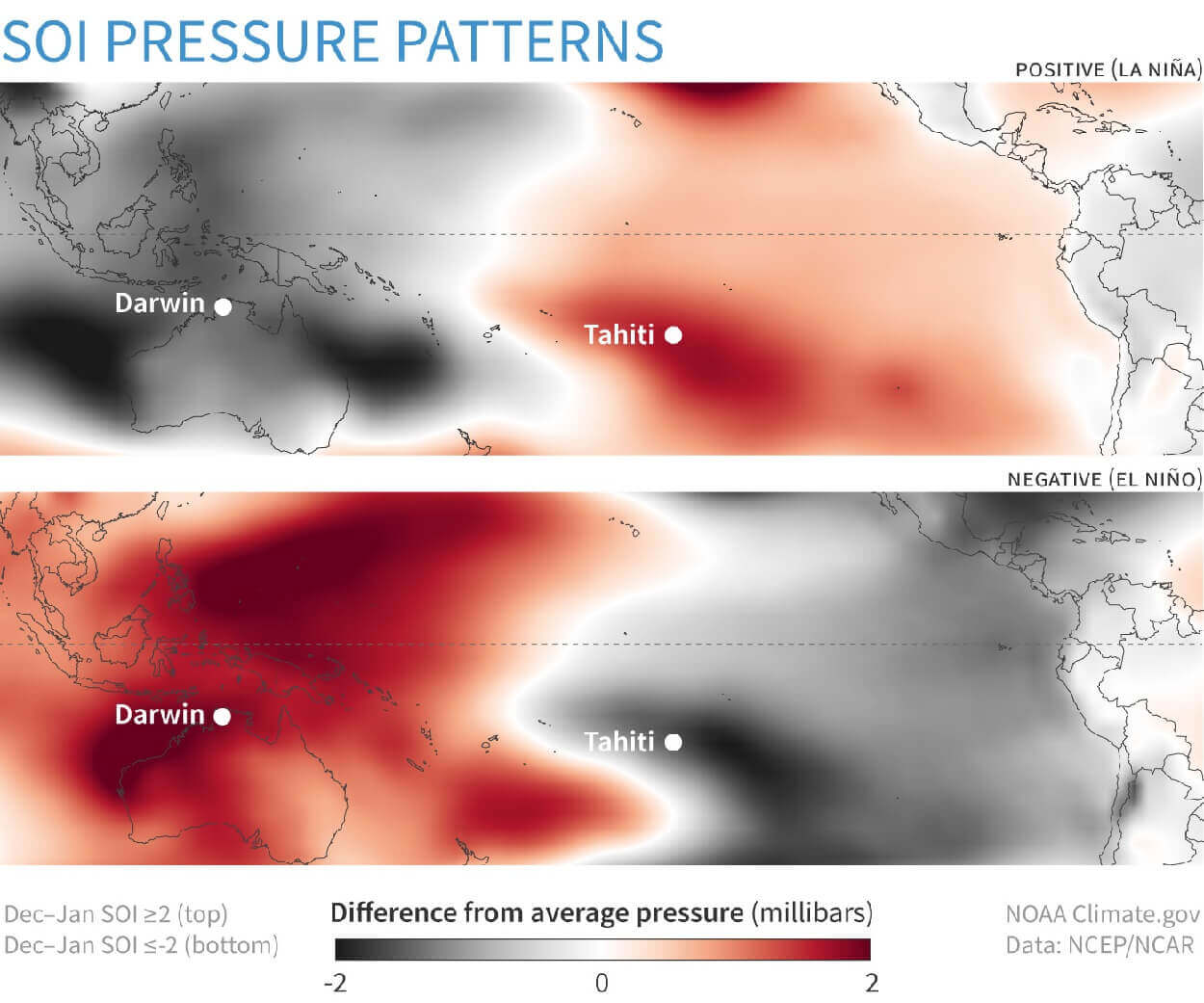
Positive SOI values mean the pressure over the Tahiti side is higher than over Darwin in Australia. This corresponds to stronger easterly trade winds, supporting La Niña conditions.
But during an El Niño, we see lower pressure in the eastern Pacific, over Tahiti, and higher pressure over Darwin. This produces a negative SOI value and weaker trade winds, which means less ocean surface cooling, or even ocean surface warming.
Looking at the SOI graph below, you can see the prolonged positive pressure phase, keeping a La Niña phase active. But now you can see a fast shift into a negative pressure phase, indicating a shift into an El Niño mode.
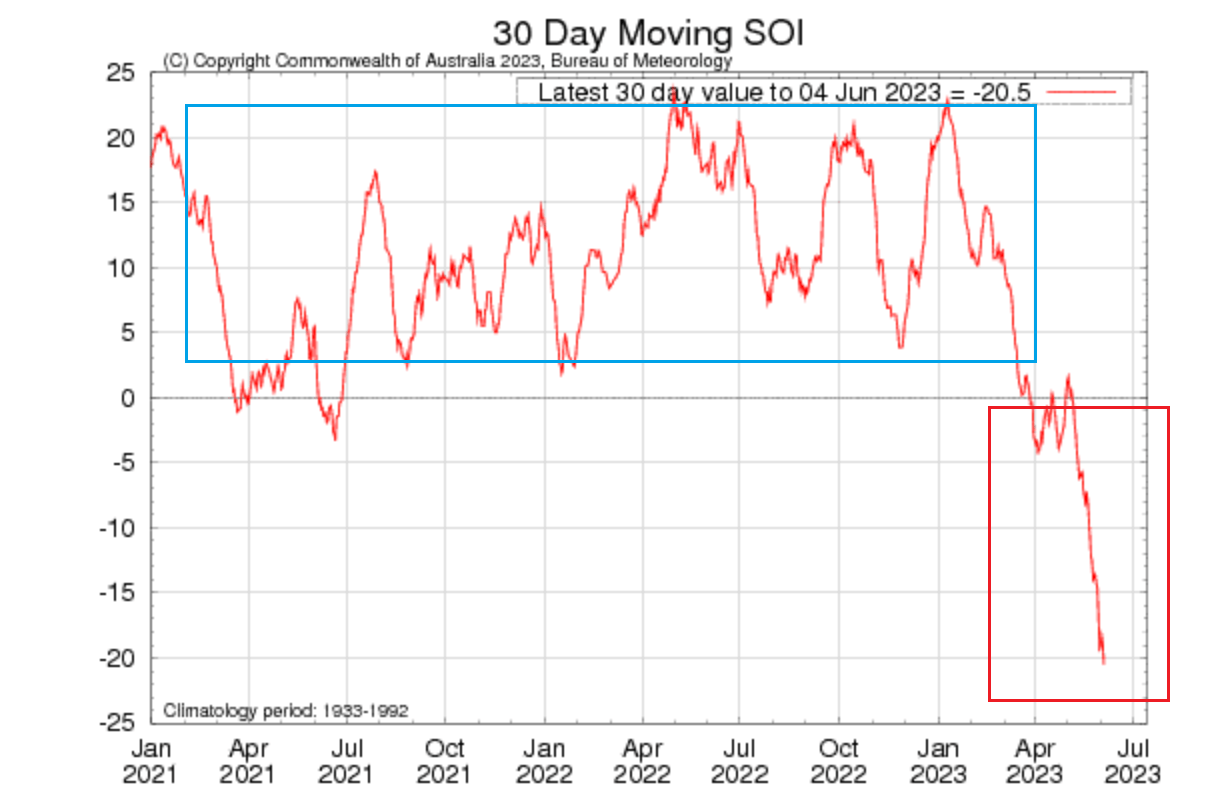
You can see this entire process in the video animation below. It shows the ocean temperature anomalies from Winter to Spring 2023.
The cold La Niña anomalies quickly broke down over the Winter, with warm anomalies emerging in early Spring. Notice the motion of the anomalies, being driven by the trade winds.
OCEAN CHANGES ABOVE AND BELOW
Another important aspect of ocean changes is the sea level height. In the image below, you can see sea level height anomalies. The marked area shows a strong ocean sea level rise, a clear sign that El Niño is now well in development. Image by NASA JPL

As described by NASA: The most recent sea level data from the U.S.-European satellite Sentinel-6 indicates early signs of a developing El Niño across the equatorial Pacific Ocean. The data shows Kelvin Waves 2 to 4 inches (5 to 10 centimeters) high at the ocean surface and hundreds of miles wide, moving from west to east along the equator.
But what are these Kelvin waves?
The best example of an oceanic Kelvin wave in action can be seen in the image below. It shows the subsurface ocean temperature anomalies in early April. The large below-surface warm pool is the Kelvin wave, growing larger and spreading towards the east and up to the surface, where it comes to the surface.

A strong subsurface warm pool is the main pre-condition to kickstart an El Niño event. That is why we closely monitor the atmospheric winds and ocean currents across the tropical Pacific.
The changes in the ocean heat content are mainly due to the expansion and rise of the strong subsurface warm pool, seen in the previous image. That is also what causes the sea level height increase, usually associated with warmer waters.
Looking at the ocean heat content graph below, you can see the strong cold phase in 2022 associated with La Niña. But notice the strong shift into warm anomalies in March, as the Kelvin wave expanded east across the equatorial Pacific, warming the upper ocean levels.

This has prompted NOAA Climate Prediction Center to issue an official El Niño watch by April. The watch continues, with the latest outlook giving a greater than 90% chance of El Niño impacting the next Winter season of 2023/2024.

In their latest discussion, they write: “The most recent IRI plume also indicates El Niño is likely to form during the May-July season and persist into the winter. The combination of a forecasted third westerly wind event in mid-late May, and high levels of above-average oceanic heat content, means that a potentially significant El Niño is on the horizon.”
Basically, it means that the current and expected atmospheric conditions will be favorable for a significant El Niño event to develop and impact the upcoming weather seasons.
THE EL NINO GROWS
Below you can see the ENSO region anomaly data for 2023. Notice the rapid rise in ocean temperatures, as the region was still coming out of an active La Niña phase in January. The grey lines show all first-year El Niño events since 1950, giving a projected/expected trend of development.

Looking more closely at the latest analysis of the ENSO regions below, you can see a strong warm belt now appearing across the equator. And not only that, you can see strong warm anomalies are now entering the eastern parts of the ENSO regions, exceeding 4 degrees Celsius.

Below we have the latest 7-day ocean temperature change, where you can see a warming trend in the central and western ENSO regions. The warming trend has temporarily halted in the eastern ENSO regions, due to regular sub-seasonal atmospheric patterns.

Another useful parameter is the degree heating weeks (DHW). In this context, we can use it to track sustained sub-seasonal conditions in ocean temperatures. And here, it shows a strong sustained warm zone in the far eastern ENSO regions, now expanding across the equator.

When looking at the ocean analysis, we also have to look at the ocean anomalies below the surface, at depth. Below you can see the subsurface ocean anomalies across the ENSO regions, showing a strong warm belt, with the strongest anomalies in the eastern regions.
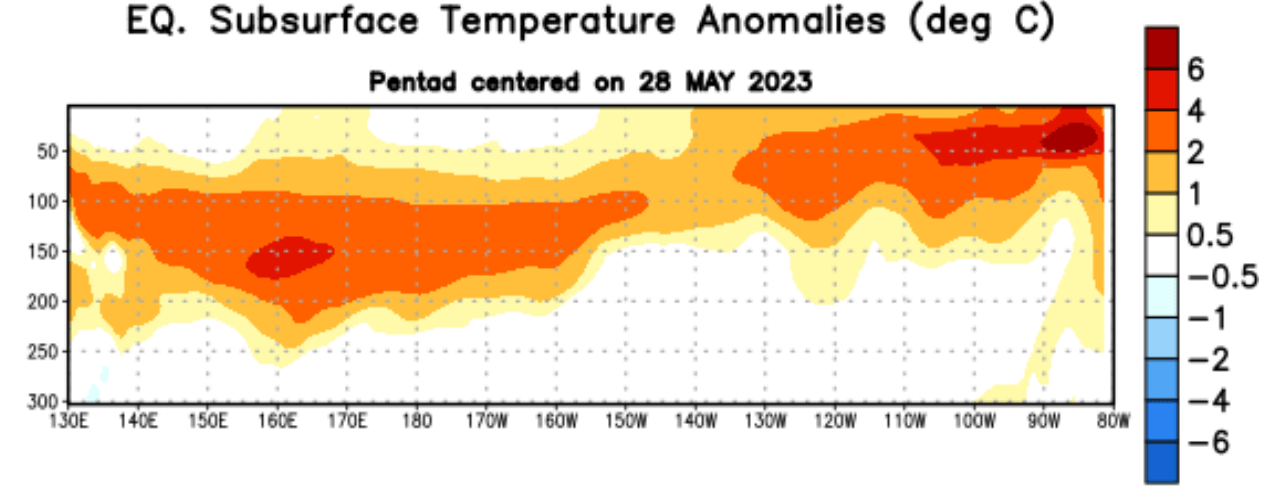
GLOBAL ANOMALY
But while the El Niño is developing, the global oceans around it are no less warm. Some regions like the Atlantic Ocean, even reach unusual values for this time of year.
Below is the latest global ocean analysis from NOAA, and we have marked 3 important areas to watch. First is the North Pacific, currently running well above normal anomalies. Second is the North Atlantic. Notice a strong anomaly area, spanning from the equator up to the polar circle.

Last but not least, you can see the ENSO regions and the developing El Niño warm anomalies. But overall, the global oceans are warmer than normal.
The image below shows the daily sea surface temperatures globally. Notice the last 2 months being the warmest in the past 40 years, and likely even more. And this is with the El Niño just starting to develop.

This is a very unique situation, with abnormally warm North Pacific, North Atlantic, and the rest of the globe running warmer on average. Usually, there is a larger contrast with an El Niño, but this year, the oceans are already running record warmest, without the El Niño properly developed yet.
We are entering uncharted waters with such a global configuration, so this El Niño might be something we have not seen before yet.
A MESSAGE IN A BOTTLE
One indicator of future development can also be found in the far eastern ENSO regions (1+2). These regions are among the first to respond to changes in the trade winds and can be used as a potential indicator for development across the entire ENSO region.
Looking closer at the far eastern regions (1+2), you can see the strong anomalies in the image below from early April. Peak anomalies were in the range of 6 to 7 degrees Celsius above normal, which is excessive. Image by NASA.

Below is the NOAA monthly analysis of the far eastern ENSO regions. You can see a rapid temperature anomaly increase in March that continues into April and May. June will likely stay at the same levels.
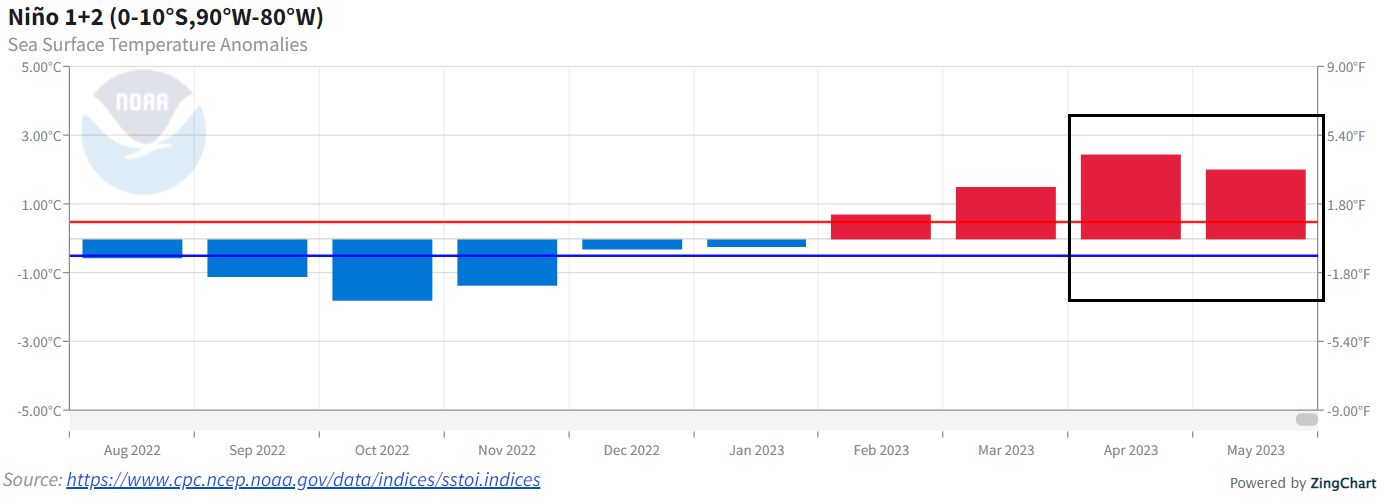
Looking at the main ENSO phases, you can see the rapid warming trend in regions 1 and 2. Central Region 3.4 also follows behind, now also showing a positive anomaly, as is eastern region 3.
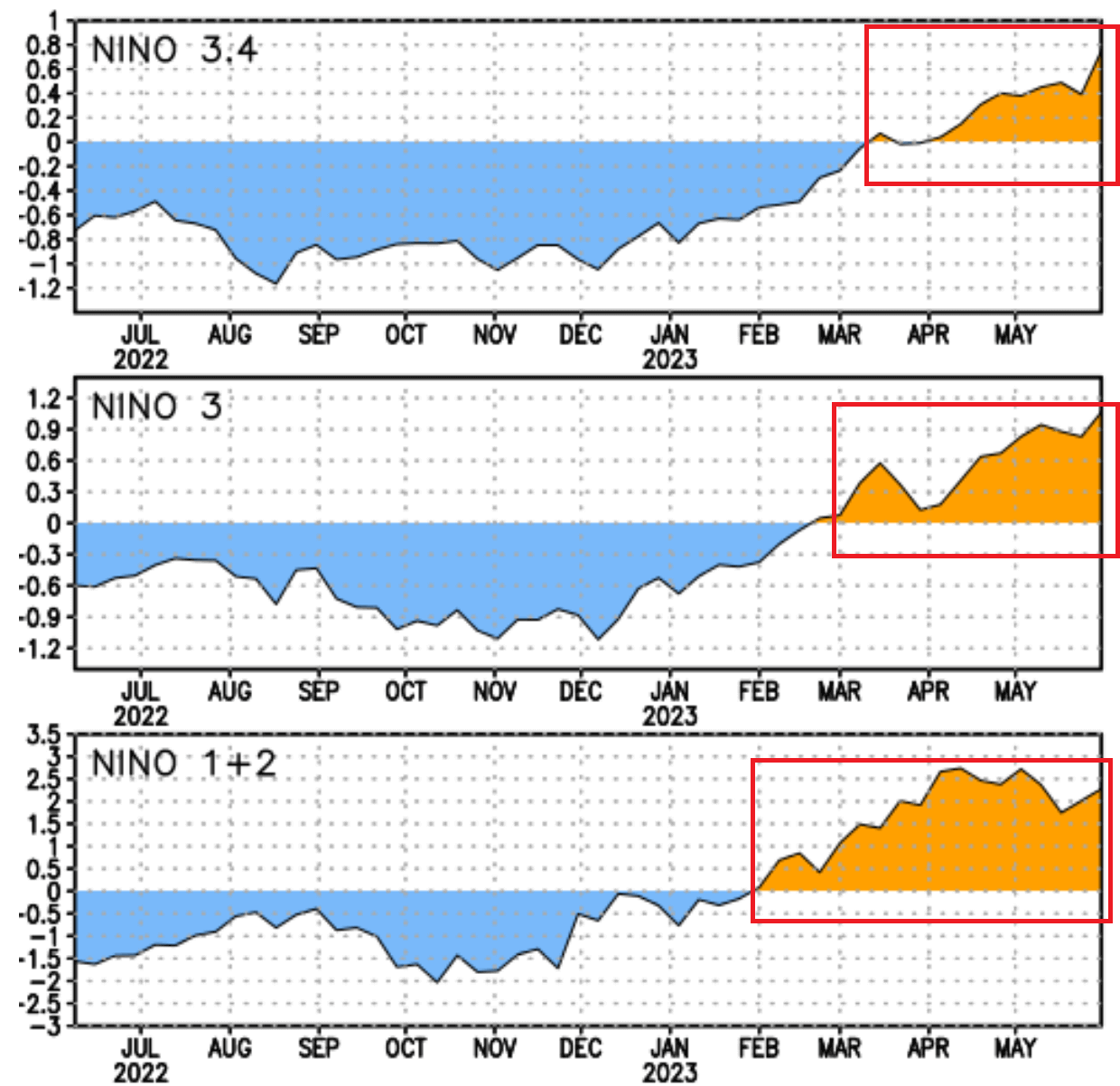
This is important because, in many historical cases, the far eastern regions 1 and 2 were somewhat of an indicator of the overall strength of the upcoming El Niño. For example, that can be seen in the NOAA PSL image below, where strong anomalies in the 1+2 regions preceded the stronger El Niño events, and this year is currently the highest at this time of year.

We will now look at the latest forecast trends for the upcoming El Niño event.
EL NINO 2023 LATEST FORECAST
Below you can see the ensemble forecast for the 1+2 ENSO regions, which we just mentioned. Again, a rapid rise in temperatures is seen, with the anomaly forecast ranging at around 3 degrees above normal. Based on historical data, this signals that a strong El Niño event could be in the works.
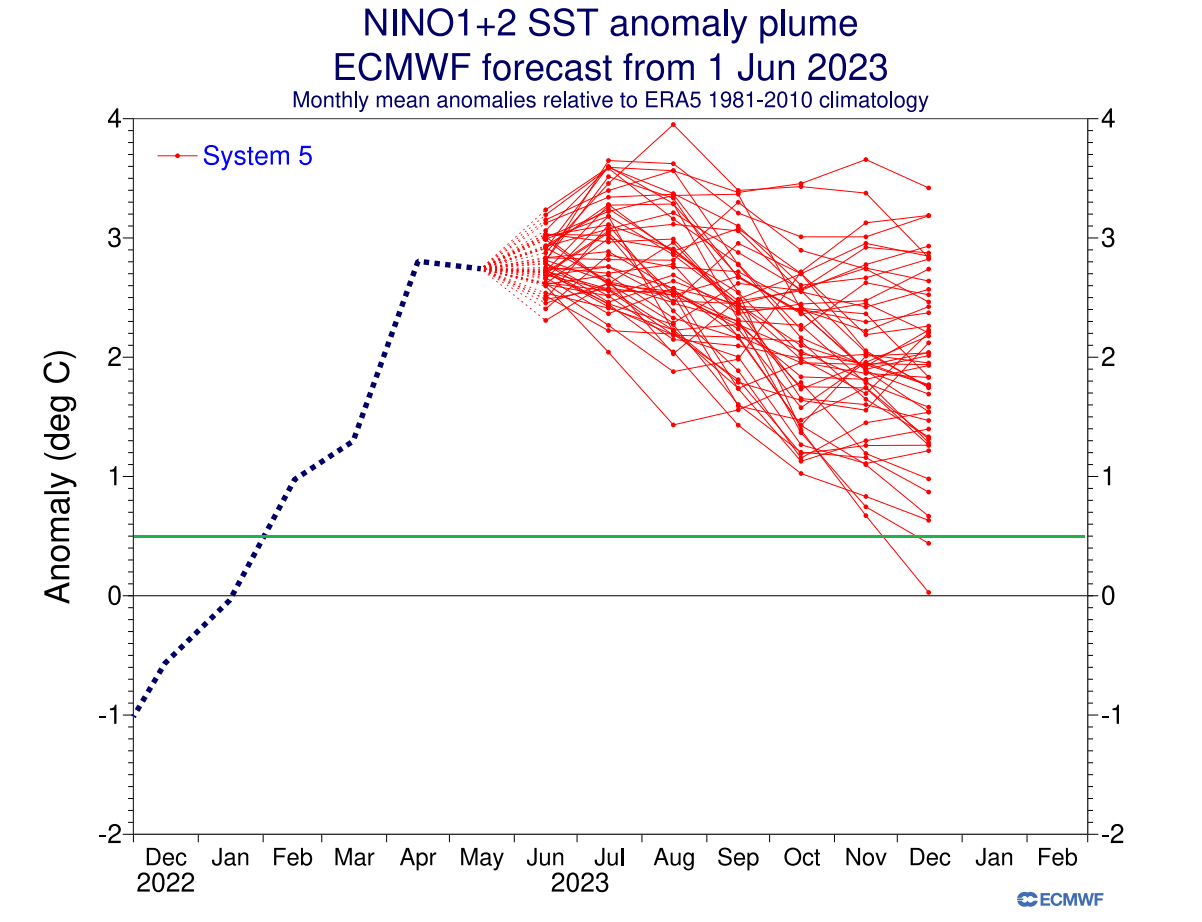
And below, you can look at the latest seasonal forecast for the main ENSO region. The ECMWF forecast takes it close to the 2 degrees above normal range by Fall, which is considered a strong El Niño event. The stronger the event is, the stronger its seasonal weather impact can be.

Looking at the extended seasonal ENSO forecast from ECMWF, you can see the ensemble consensus for a rather strong El Niño event. The green line is the El Niño threshold (+0.5 degrees). The anomalies are forecast to peak into the strong territory, lasting at least into early Spring of 2024.

The IRI official probabilistic ENSO forecast has shifted into full El Niño mode, already giving a full El Niño state this Summer. The event is very likely to influence the weather patterns over the entire 2023/2024 Winter season.

Looking at the Fall (Autumn) ocean forecast by the ECMWF, you can see a strong El Niño event expanding across the entire tropical Pacific. Another area of interest is the unusually warm ocean area in the North Atlantic, which can also play its role in the grand weather picture.
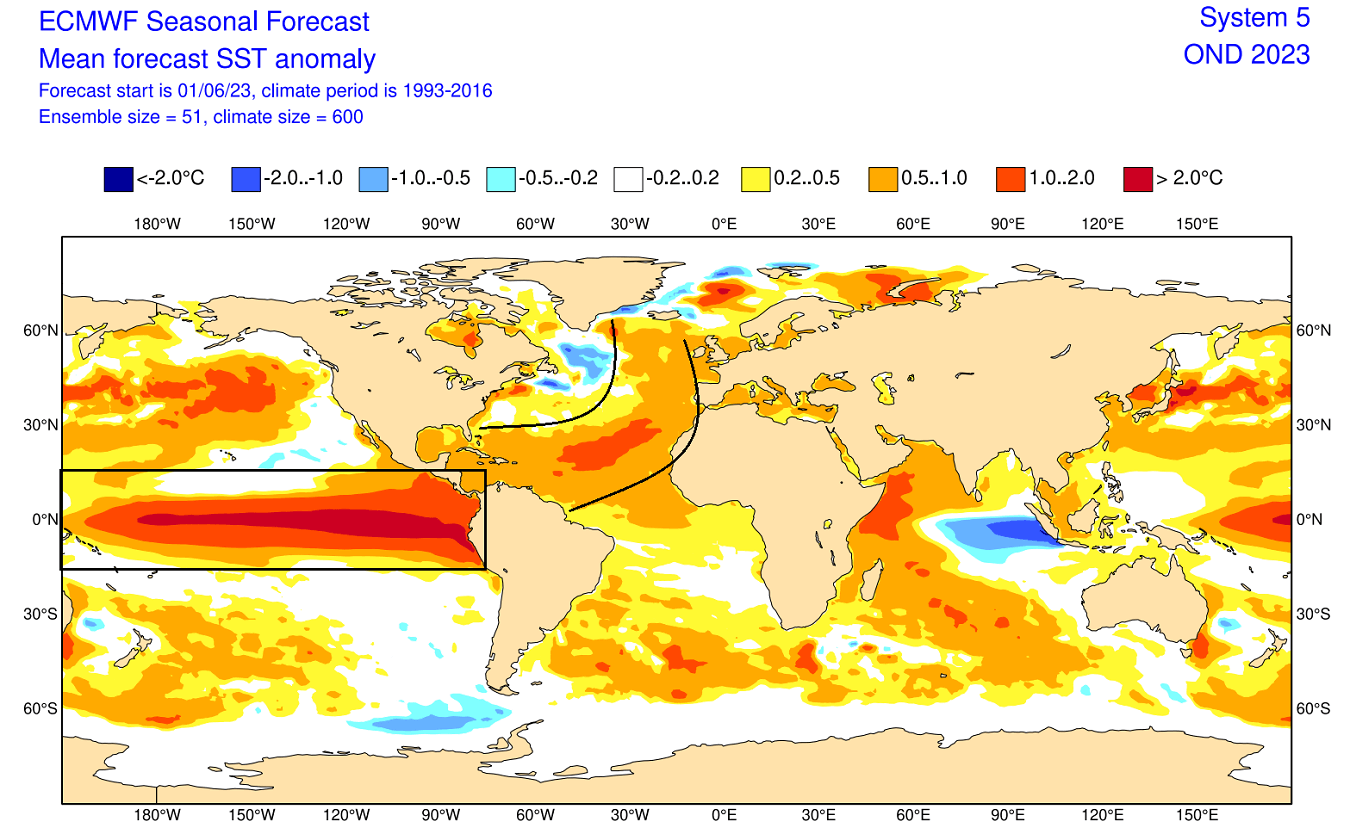
Also, looking at the subsurface forecast below by the CFS, we can see a strong warm pool taking over the tropical Pacific regions over the Summer. This signals a very healthy El Niño event, becoming one of the main weather drivers over the Winter season.
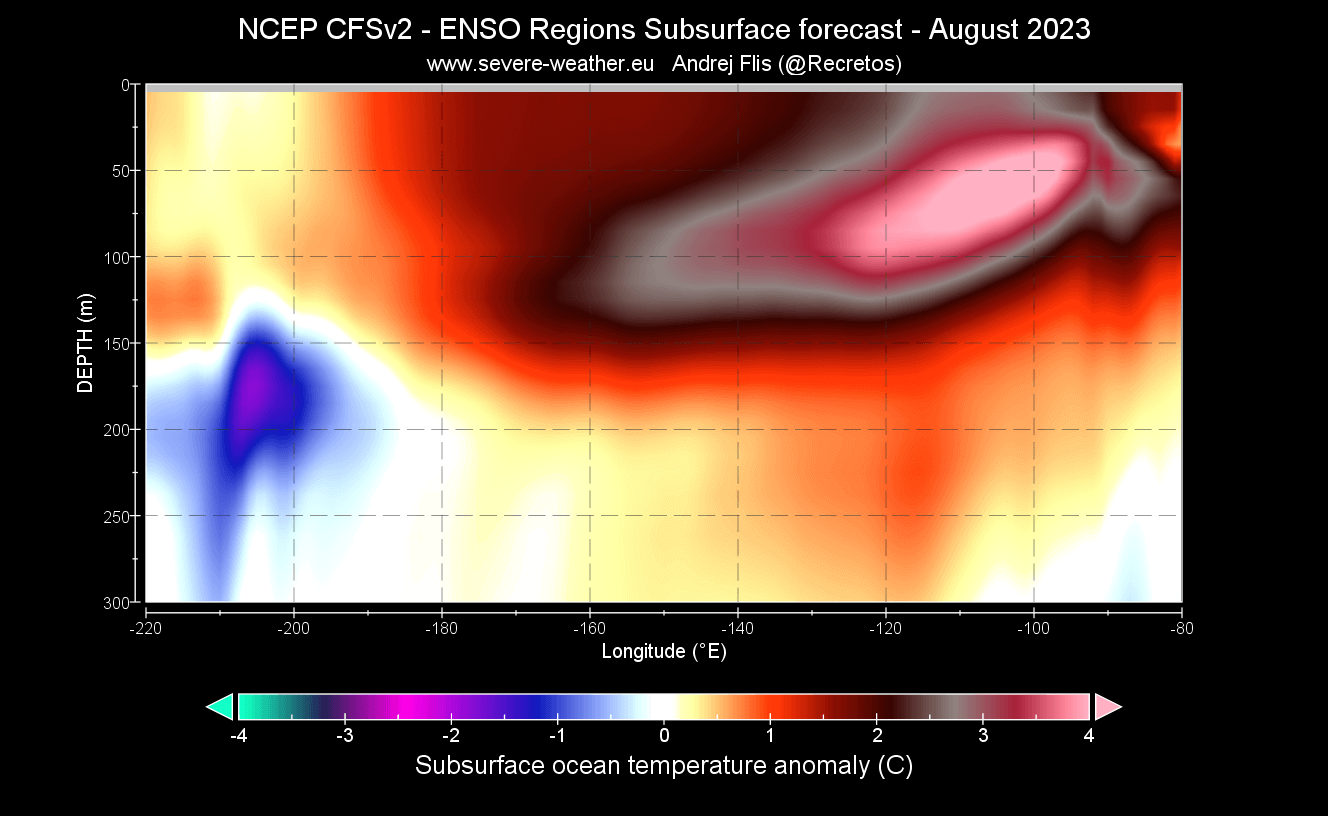
The North American multi-model ensemble forecast (NMME) also shows the same anomalies developing into Fall. The EL Nino is very well developed and is forecast as moderate to strong even in the forecast.
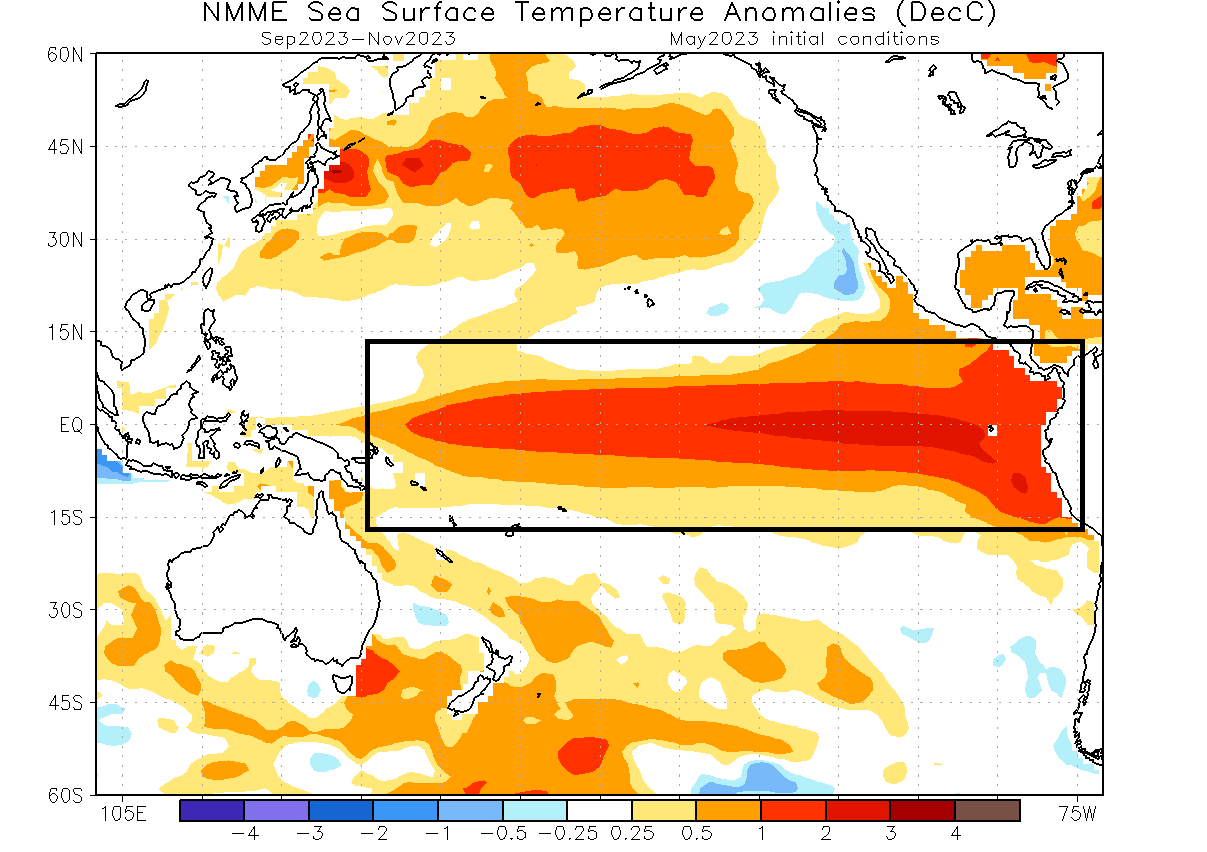
Looking also at the NMME ensemble plume forecast for the ENSO regions, it shows a weaker even than ECMWF for example, but still being a moderately strong even, capable of spreading its impact into the next Winter season.
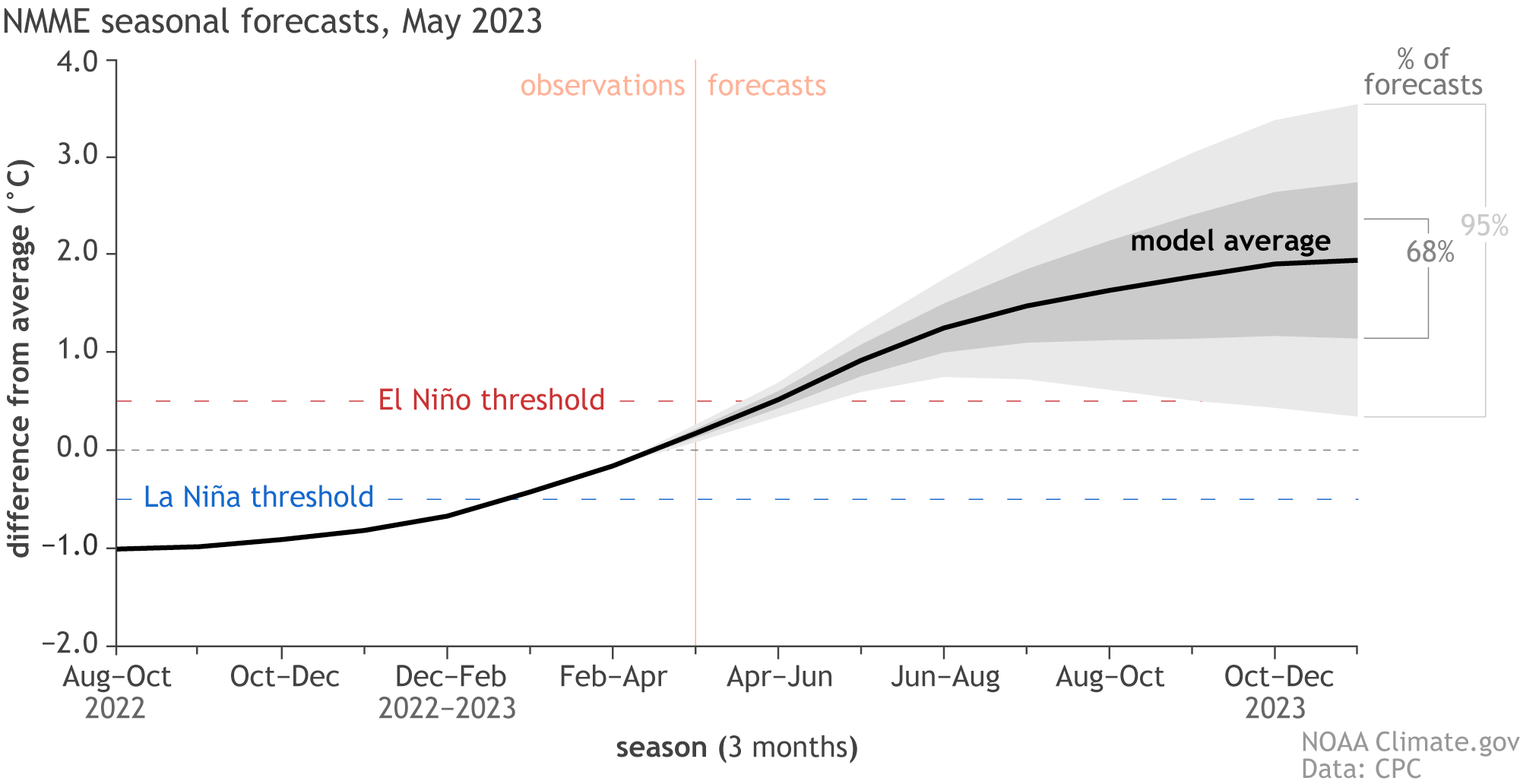
Based on all this forecast data, we know what to expect in the oceans. But what can we expect in the atmosphere, based on the upcoming El Niño event?
EL NINO ATMOSPHERIC WEATHER PATTERNS
During the El Niño winter season, there is typically a strong and persistent low-pressure area in the North Pacific. That pushes the polar jet stream further north, bringing warmer-than-normal temperatures to the northern United States and western Canada.
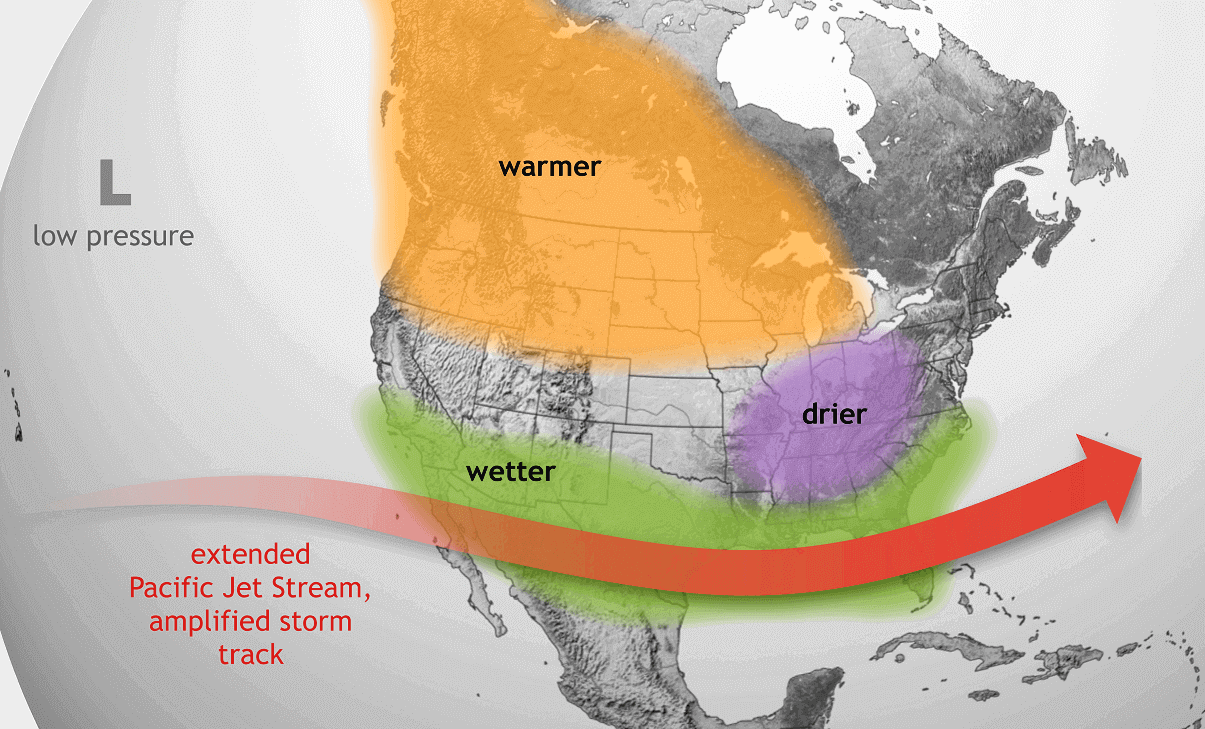
But the southerly Pacific jet stream is amplified during an El Niño, bringing storms with lots of precipitation and cooler weather to the southern United States.
We can already see that in the latest pressure forecast for October to December 2023 period below. You can see a low pressure over the western United States and the Atlantic. That amplifies the subtropical jet stream, marked with blue arrows.
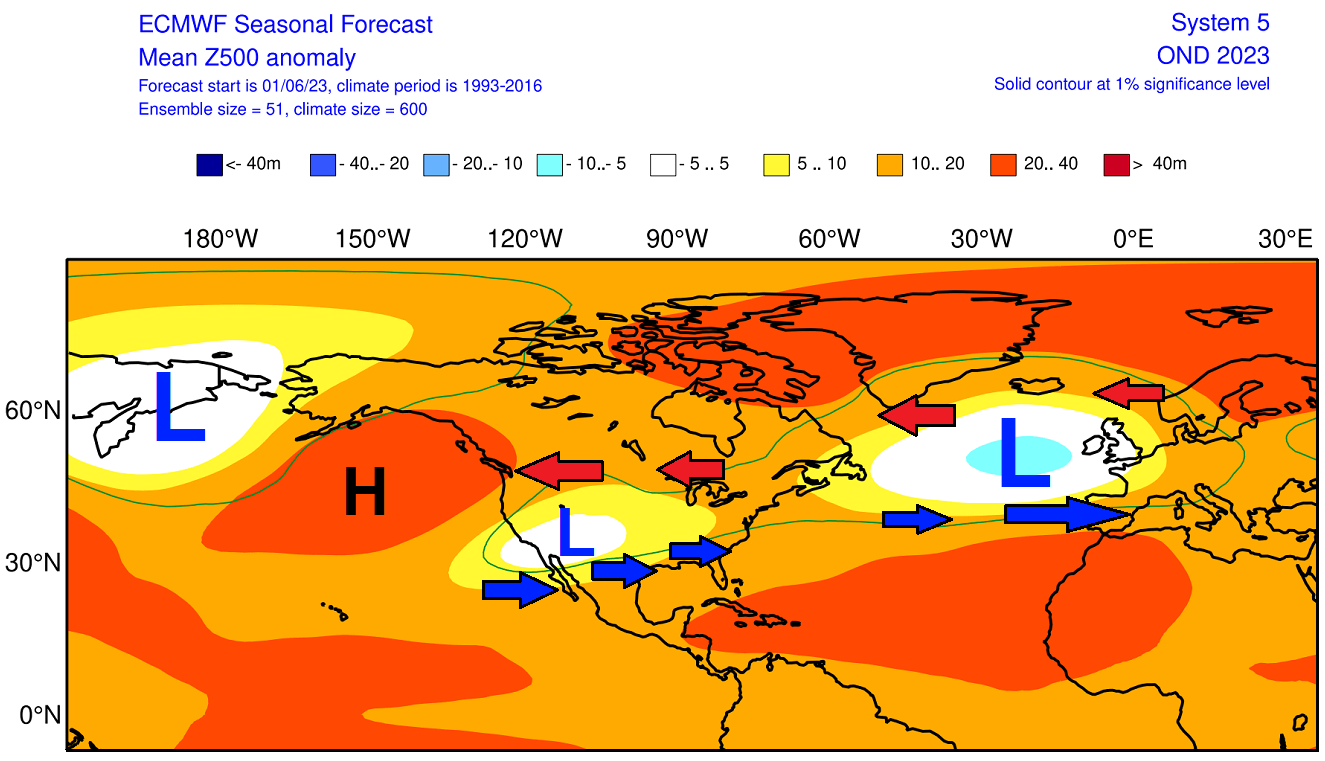
On the other hand, this circulation also weakens the polar jet stream, marked in red arrows. This pressure pattern creates a different temperature than we have seen in the past few years with a La Niña.
Below are temperature anomalies for some of the last El Niño winters. You can see the average El Niño winter having colder temperatures in the southern half of the United States and parts of the eastern United States. The northern half of the country is warmer than usual, with the anomalies spreading into southern Canada.
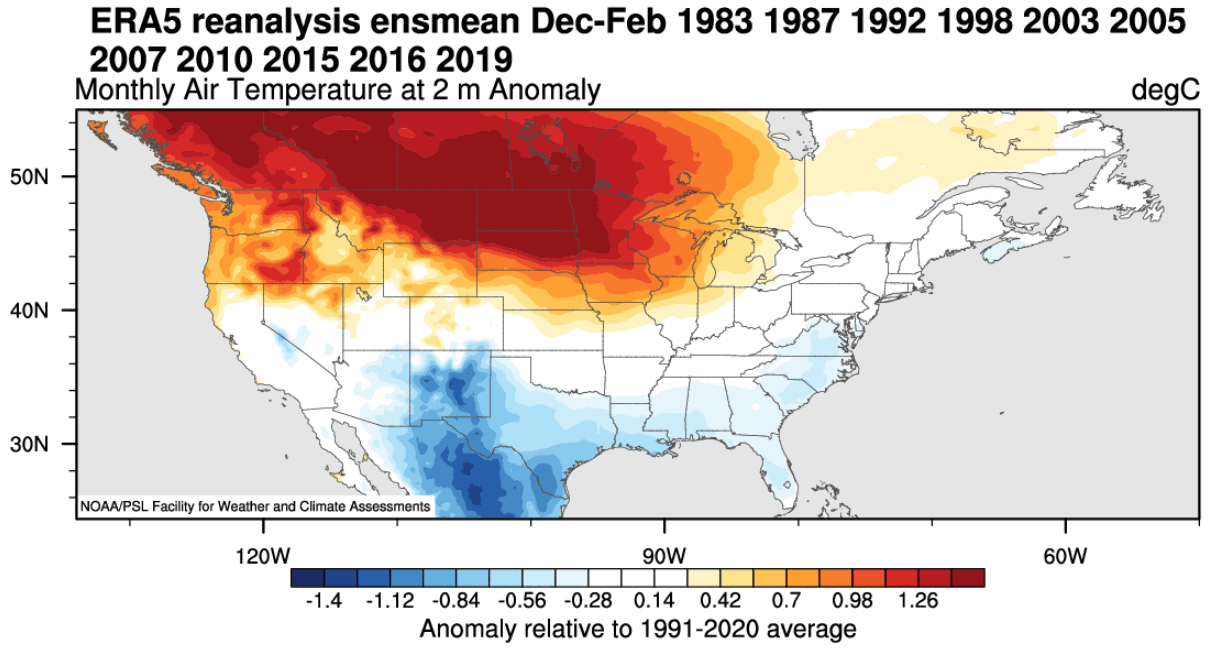
Precipitation-wise, an El Niño winter brings more precipitation to the southern half of the United States, especially in the southeast, due to the stronger subtropical jet stream. The image below shows the areas with more precipitation during the El Niño winter season.

You can see that much of the southern parts of the United States and the plains typically see more precipitation during an El Niño.
Next below is an image that shows areas with less precipitation during an El Niño winter. You can see less precipitation in southern Canada, around the Great Lakes, in the upper Midwest, and over the northwestern United States,
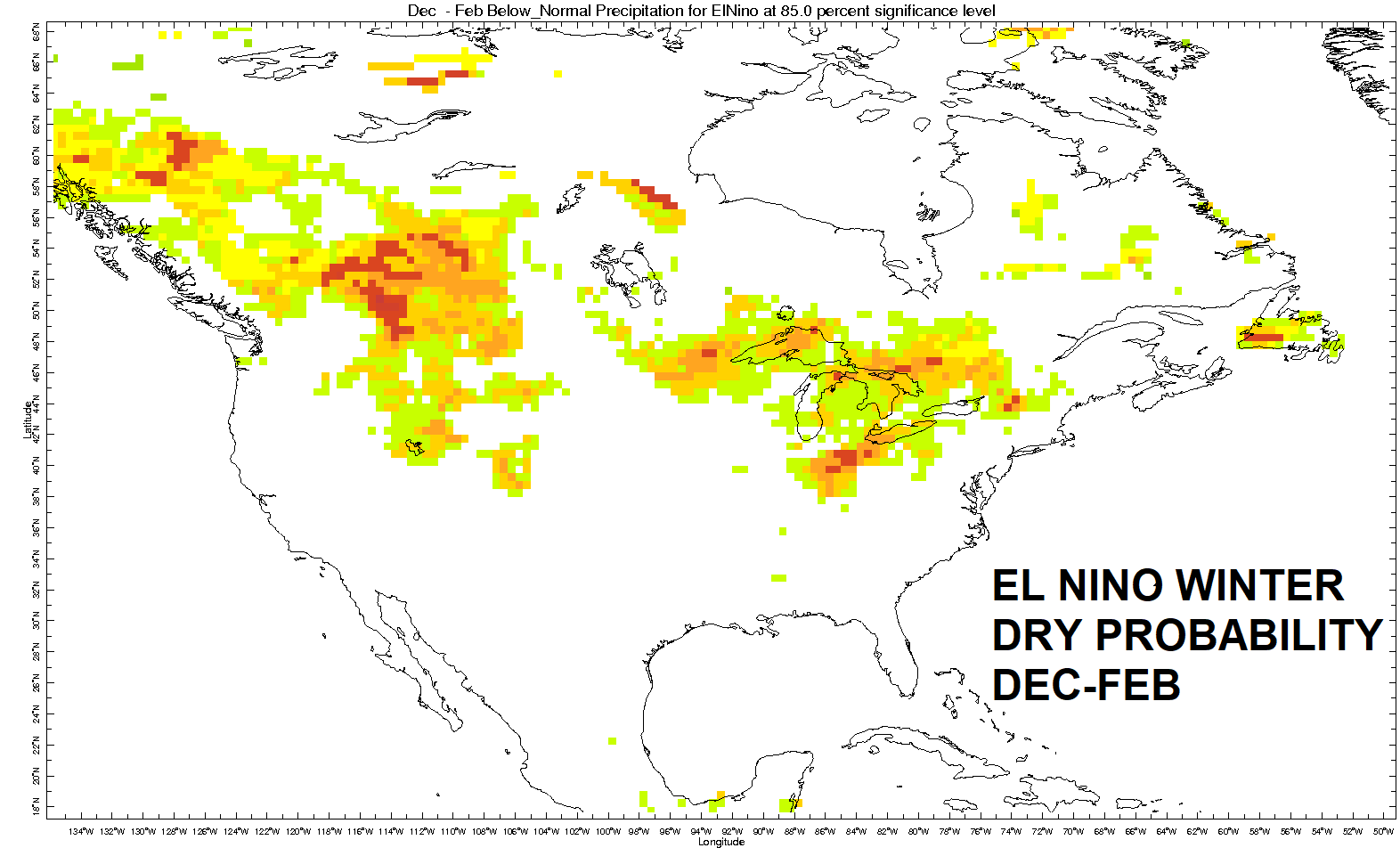
An El Niño event also changes the snowfall patterns, as seen in the image below. There is typically less snowfall in the northern United States during the El Niño winters. But more snowfall is seen in the central and southern United States during an El Niño. And also over parts of the east. This corresponds to the precipitation anomalies.

This is mainly due to low-pressure systems trailing across the southern United States. With cooler air available and more moisture, the chances of snowfall increase in the southern half of the country. But a lot depends on the availability of the cold air from the north.
EUROPE AND ENSO
After passing Canada and the United States, the jet stream moves into the North Atlantic, where it can take different paths toward Europe.
But the ENSO effects are much less direct in Europe than in North America. That is why we focus more on North America to track direct (and more predictable) weather changes.
But still, looking at the historical connections of ENSO to Europe, we produced some graphics below. First is the Winter pressure anomaly signal. It shows a high-pressure tendency over most of Europe, with the subtropical ridge expanding during an El Niño winter season.

The following temperature is, of course, warmer than average over much of the continent. But the signal has a weak strength, as the ENSO influence loses most of any direct impact this far out. So while there is a signal in the average, it cannot be used for any direct weather pattern forecasts over Europe.

Looking at the precipitation, you can see the more precipitation probability below. It shows areas of increased precipitation in winter during an El Niño event. You can see more precipitation over central Europe and the southwest.
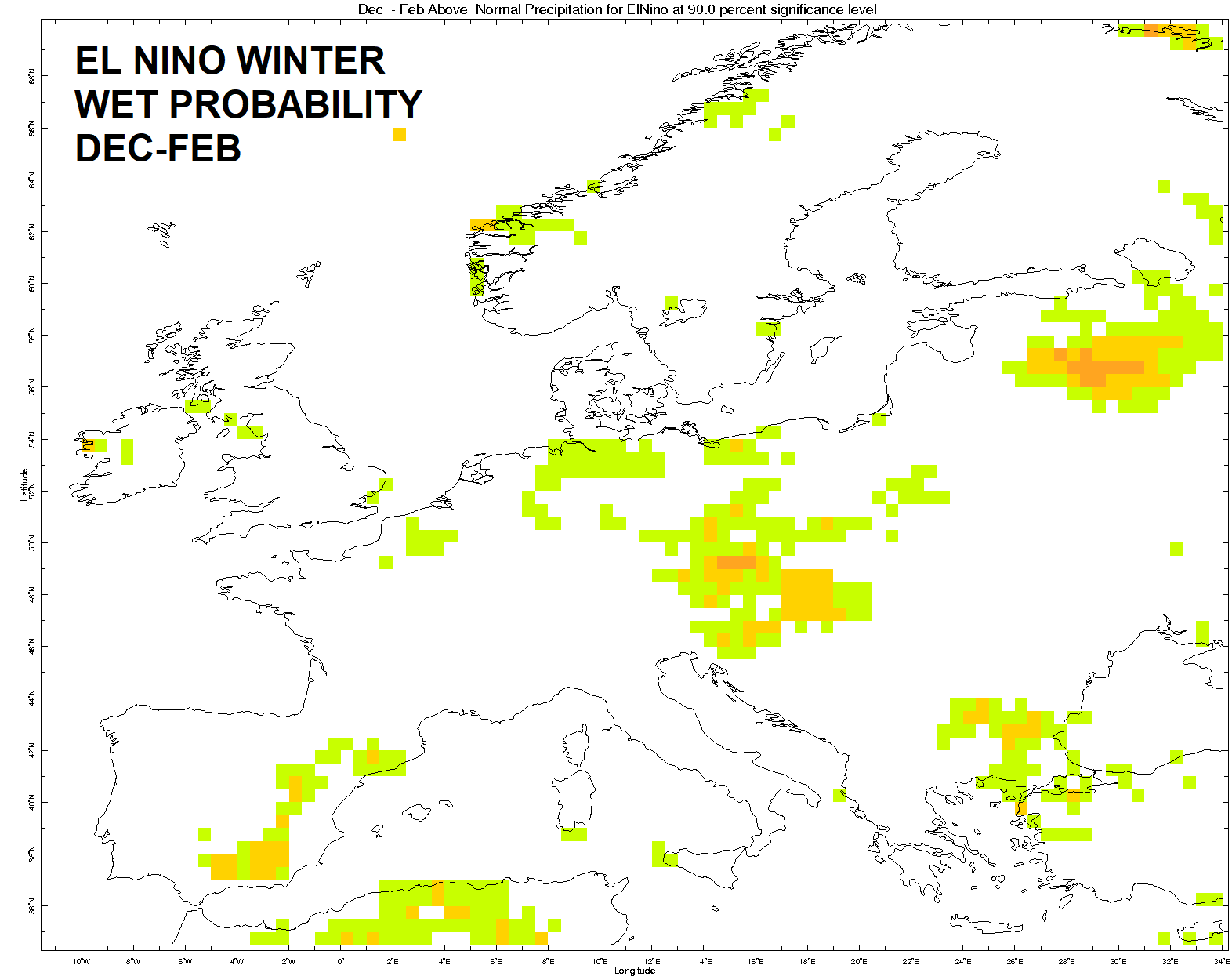
The next image shows the probability of less precipitation and drier winter conditions than usual. You can see that in an El Niño winter, there is less precipitation over southeastern Europe and Scandinavia.

As El Niño changes the weather globally, hardly a corner of the world does not feel its effect. But the weather changes in parts further away are less predictable. That is because local weather systems play a specific role, as well as other global weather drivers.
EL NINO AND THE HURRICANE SEASON
Based on the available data, it is well known that an El Niño event reduces the number of Hurricanes and tropical systems overall in the Atlantic. The reason is stronger wind shear, preventing the storms from organizing and powering up into large systems.
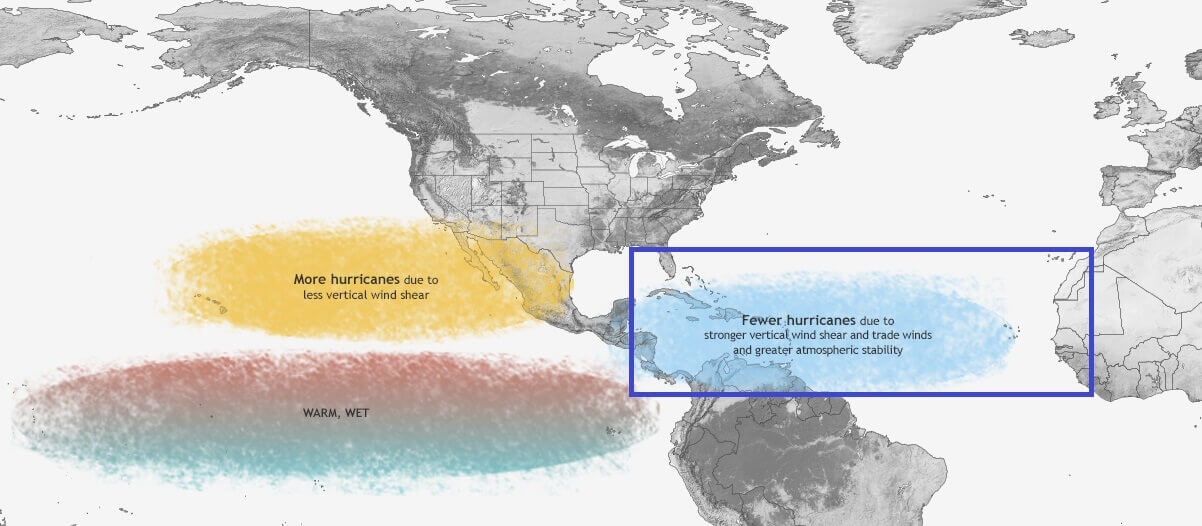
We produced a historical re-analysis of pressure trends during an El Niño event. As you can see, there is mostly higher pressure across the tropical Atlantic, right in the main development region of tropical systems.

This shows a tendency of having less or weaker low-pressure systems in the main development region during the Hurricane season, due to the El Niño influence.
Also, looking at precipitation, you can see much drier trends across most of the tropical storm regions. During an El Niño hurricane season, the Gulf of Mexico, the Caribbean, and most of the tropical Atlantic are drier than average.
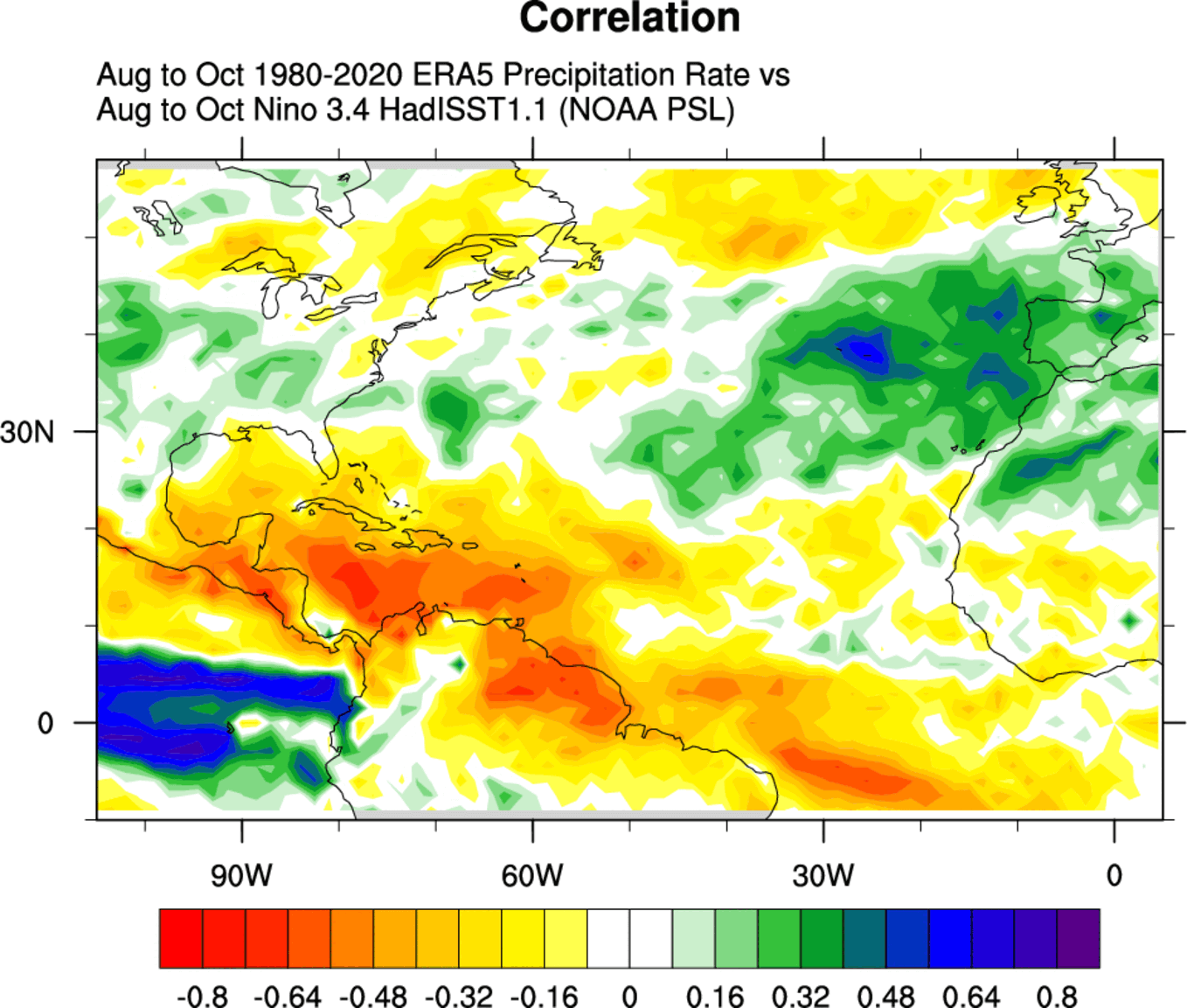
This is mostly a result of higher pressure and more stable conditions across the board. This means fewer tropical storms and weaker systems. So an El Niño can greatly reduce the chance of a strong hurricane impacting the United States.
But, this still does not mean that no storm can reach the coast of the United States. The number of storms is lower, as is their strength. But only one storm is enough to do major damage to the coastal areas.
We will keep you updated on global weather development and long-range outlooks, so bookmark our page. Also, if you have seen this article in the Google App (Discover) feed, click the like (♥) button to see more of our forecasts and our latest articles on weather and nature in general.
Don’t miss:
"severe" - Google News
June 07, 2023 at 10:59AM
https://ift.tt/VACl5XD
El Niño is now developing rapidly, with long-range data already showing a strong event is likely, impacting the Fall and ... - Severe Weather Europe
"severe" - Google News
https://ift.tt/jnLgkWB
Shoes Man Tutorial
Pos News Update
Meme Update
Korean Entertainment News
Japan News Update
Bagikan Berita Ini















0 Response to "El Niño is now developing rapidly, with long-range data already showing a strong event is likely, impacting the Fall and ... - Severe Weather Europe"
Post a Comment